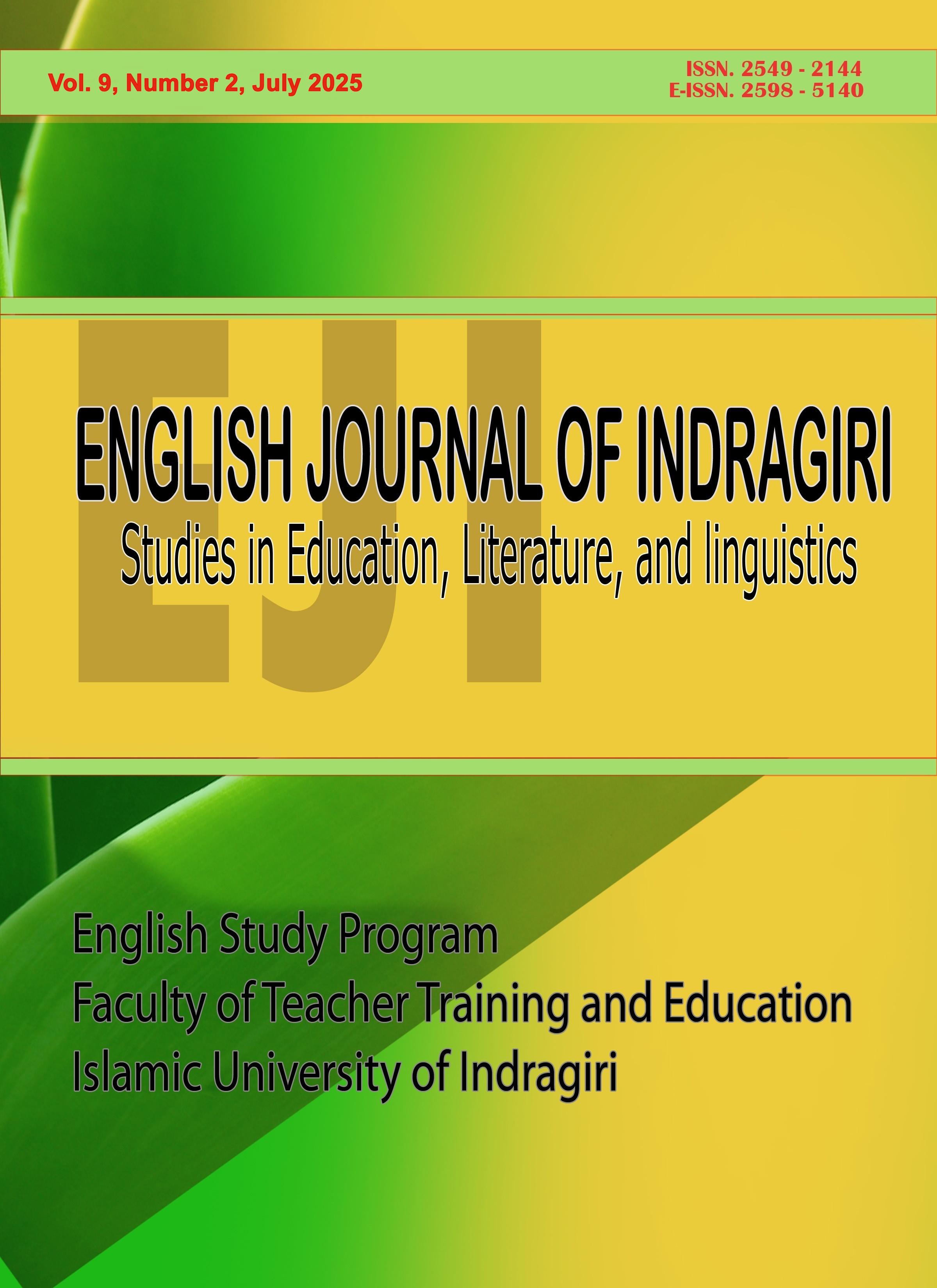A Qualitative Study on the English Accent Pronunciation of Indonesian Native Speakers
DOI:
https://doi.org/10.61672/eji.v9i2.3006Keywords:
Local accent, pronunciation, native speaker, sociolinguisticsAbstract
This study aims to analyse the influence of local accent on English pronunciation among English Department students. In the context of Indonesia, which is rich in regional language diversity, local accents often affect the pronunciation of English vocabulary, especially on sounds that are not found in the speakers' native language. This challenge is important to note, given that proper pronunciation greatly affects the ability to communicate in English. To investigate this, the research method used was a descriptive qualitative approach with data collection techniques in the form of recorded speaking tasks and in-depth interviews. This study involved 30 students who came from various regional backgrounds. The results revealed that most students were still affected by regional accents, such as the pronunciation of the phoneme /θ/ into /t/ or /s/, as well as intonation patterns that were not in accordance with English standards. For example, the word “think” is often pronounced as “tink” or “sink”. These findings indicate the need for a more intensive phonetic approach in teaching speaking in English classes, as well as the development of teaching materials that are more responsive to the diversity of local accents. Thus, this study is expected to contribute to the development of English curriculum and teaching methods in Indonesia.
References
Anggara, D. Y., Fikry, S., & Lubis, Y. (2025). An Analysis of Common Errors in
Conversation. MUDABBIR Journal Research and Education Studies, 5(1),
–344.
Awwali, J. N., Indrayani, L. M., & Amalia, R. M. (2024). PRONUNCIATION
VARIABILITY OF ENGLISH DENTAL FRICATIVES AMONG
SUNDANESE LEARNERS IN DIFFERENT ACADEMIC DISCIPLINES.
English Review: Journal of English Education, 12(2), 765–776.
Braun, V., & Clarke, V. (2021). Thematic analysis: A practical guide.
Butarbutar, O., & Ekarina, E. (2025). EXPLORING THE EMERGING NON
STANDARD ENGLISH PRONUNCIATION FEATURES OF L1
JAVANESE AND INDONESIAN SPEAKERS. Journal of English Language
and Culture, 15(1).
Djokaho, M. P. E., & Azizah, A. T. (2024). USE OF MOTHER LANGUAGE AS
A COMMUNICATION TOOL INTRODUCING INDONESIAN
LANGUAGE AT AL-IMAN TERONG KINDERGARTEN EAST
ADONARA DISTRICT. Santhet (Jurnal Sejarah Pendidikan Dan
Humaniora), 8(1), 927–931.
Fitriana, D., & Agustian, A. F. (2025). Voices of Proficiency: Insights into EFL
Pronunciation Teaching Challenges in Indonesian Middle School Teachers.
JEPAL (Journal of English Pedagogy and Applied Linguistics), 5(2), 211–222.
Funada, N. (2025). Effects of Students’ Contact With the English Language and Its
Users on Students’ Preferences for Global Englishes Language Teaching.
TESOL Quarterly, 59(1), 197–224.
Hasanah, S., . H., & Pradipta, P. (2024). The Diglossic-Bilingual of English-Arabic
EJI (English Journal of Indragiri): Studies in Education, Literature, and Linguistics
Vol. x. No. x, month Year
ISSN (Print). 2549-2144, ISSN (Online). 2589-5140
Homepage: https://ejournal-fkip.unisi.ac.id/index.php/eji/
Second-Language Eventualities in Madurese-Scholar’s Society. KnE Social
Sciences, 2024, 197–223. https://doi.org/10.18502/kss.v9i9.15671
Islam, R. (2023a). Parents’ Perception and Involvement toward English for Young
Learners in Rustic Area. Jurnal Pendidikan, 9(2), 2548–4419.
Islam, R. (2023b). Teaching Material and Method toward English Students at
Vocational High School. Journal of English Language Teaching and Cultural
Studies, 6(2), 167–175. https://doi.org/10.48181/jelts.v6i2.21373
Jiang, Y., Gai, X., Wang, Z., & Thomson, J. (2024). The influence of segmental
and suprasegmental phonological awareness on word and pseudoword
reading—A comparison between native English speakers and native Chinese
speakers of English. Frontiers in Psychology, 15, 1214197.
Jorge Arias, K. A., & Torres Herrera, M. V. (2024). English pronunciation errors
of the sounds/θ/and/ð/made by second level efl students of the Technical
University Of Cotopaxi. Ecuador: Pujilí: Universidad Técnica de Cotopaxi
(UTC).
Kosasih, M. M. (2021). Factors affecting Indonesian students in learning English
pronunciation. International Research in Higher Education, 6(3), 13.
Lubis, Y., Barus, P. A. B. B., & Rahma, A. (2025). ANALYSIS OF COMMON
ERRORS OF ENGLISH LEARNERS IN PRONOUNCING VOWEL
SOUNDS. Jurnal Publikasi Manajemen Informatika, 4(1), 145–154.
Mairano, P., Nodari, R., Ardolino, F., De Iacovo, V., & Mereu, D. (2025).
Inherently Long Consonants in Contemporary Italian Varieties: Regional
Variation and Orthographic Effects. Languages, 10(6), 118.
Putri, D. A. D. P., & Mahardika, I. P. P. (2024). Mother tongue and its implication
on second language learning: English phones production. International
Journal of Linguistics, Literature and Culture, 10(4), 82–88.
Sari, F. K., & Kurniawan, P. Y. (2025). EFL STUDENTS’PERCEPTIONS OF AI
SPEECH RECOGNITION IN PRONUNCIATION PRACTICE: THE CASE
OF GOOGLE READ ALONG. English Review: Journal of English
Education, 13(1), 205–214.
Setiawati, E., Widodo, W., Warsiman, S. S., & Ardhian, D. (n.d.). MADURA
EJI (English Journal of Indragiri): Studies in Education, Literature, and Linguistics
Vol. x. No. x, month Year
ISSN (Print). 2549-2144, ISSN (Online). 2589-5140
Homepage: https://ejournal-fkip.unisi.ac.id/index.php/eji/
LANGUAGE VARIATIONS: PHONOLOGICAL CHANGE AND ITS
RELATIONSHIP WITH LANGUAGE CHANGE AND ETHNIC IDENTITY.
Susanto, E., & Saehu, A. (n.d.). A Contrastive Analysis on Consonant
Pronunciation of English and Javanese (A Case Study in Javanese Learners of
English Departments of UIN SGD Bandung). Prosiding Seminar Nasional
Linguistik Dan Sastra (SEMANTIKS), 723–737.
Syakur, A., Sulistyaningsih, S., & Musyarofah, L. (2024). THE PERCEPTIONS
BETWEEN JAVANESE AND MADURESE SPEAKERS TOWARDS
THEIR DIALECTS IN ENGLISH CONVERSATION. Celtic: A Journal of
Culture, English Language Teaching, Literature and Linguistics, 11(1), 56
Tsang, A. (2025). The relationships between EFL learners’ anxiety in oral
presentations, self-perceived pronunciation, and speaking proficiency.
Language Teaching Research, 29(4), 1639–1659.
Xie, P., Long, X., Mu, W., Wang, J., & Wu, Y. (2025). Standard Accent vs. Local
Accent: Exploring the Role of Doctors’ Accent Characteristics in Online
Medical Services. Health Communication, 1–18.
Downloads
Published
Issue
Section
License
Copyright (c) 2025 Nafsiatul Salviya, Raudhatul Islam

This work is licensed under a Creative Commons Attribution 4.0 International License.




















